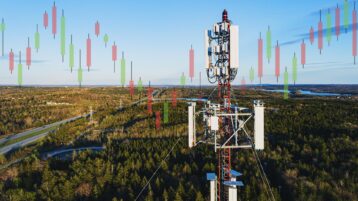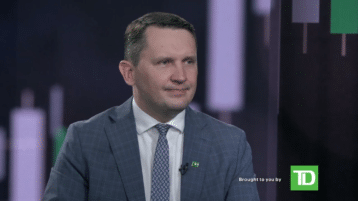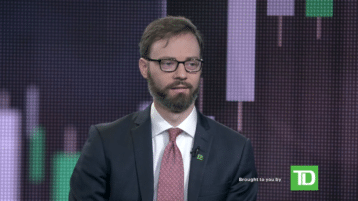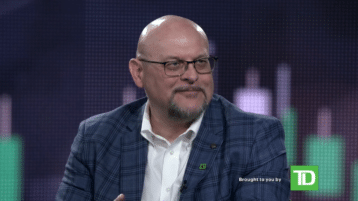Michael Craig, Head of Asset Allocation at TD Asset Management, speaks with Greg Bonnell about the recent volatility in the financial sector and what investors should be considering when approaching the markets.
Print Transcript
Investors are keeping a careful eye on the health of the global financial system that is, central banks take coordinated action to try to calm markets. And UBS agreed to buy a troubled lender, Credit Suisse. What's going on? Joining us now for his view on how to think about it all, Michael Craig, Head of Asset Allocation at TD Asset Management. Michael, great to have you back with us.
Good to be here.
Friday is not the end of it any more these days. You go home on Friday, you read the weekend headlines and you come back on Monday into the thick of it. What do we make of what's transpired in the past couple of days?
Oh, pretty historic. Fifteen years ago, it was Bear Stearns right around the same time. This week it's Credit Suisse. It takes away some anxiety from the market. Obviously, Credit Suisse was was coming off pretty hard last week. And this will give us probably some time for a breath. But the overlying issues that we're going to still remain. This is certainly probably the end of the beginning or the beginning of the end, if you think about where we're going from here.
All right. So basically what we're talking about is the global financial system. The concerns, it seems like a million years ago, Silicon Valley Bank was a week and a half ago that it failed. And then, of course, all the pressure on the US regionals wondering what the exposure is of the bigger banks to get this event where UBS steps in and buys Credit Suisse. You're saying it's sort of early innings. What do we need to be watching for as investors going forward?
Credit. I think in terms of credit availability, banks pulling back, there is data from the Fed weekly that does show assets and liabilities across the U.S. banking system. And we'll be watching for that to start to contract as banks start to pull away. The reasons for each of these failures have been very different. Silicon Valley Bank basically doing their best impression of Orange County back in the 90s. This is not an original way to blow up a bank, you had a bunch of deposits they put it in the longer term investments and that went against them. And then with Credit Suisse, they've been kind of bumping into sharp objects now for some some time. They've been in the press for any kind of mistake that's happened. It seems that they've been tied to it. So these weren't high quality business models, if you will. But we're coming back to the Fed, as you mentioned, we got a rate decision this week and the Fed's in a tough spot between, they've got this newfound problem with financial stability, but they still have an inflation problem. And so they'll have to choose in terms of what they're going to focus on. But my sense is it will be on the inflation side.
On the inflation side, right. Because there's no shortage of punditry out there right now as to what the Fed might do only two days from now. And there's a school on other things. Okay. They're still probably going to raise maybe 25 basis points to show that the fight for inflation is an important one. And then if they didn't raise and maybe they're a little more concerned about the global financial system, they want to show their hand to be. It's hard to make sense of it with only two days to go as to exactly what they'll say and what, more importantly, they might have to say about just the health of the global financial system.
Yeah, for us, to try and first predict what they're going to do and think and then actually what our return off it is is next to impossible. You need to think about what the range of probabilities are and then the expected reaction. I would say that if they do come in and hold and not do anything, that's probably going to create more damage than not. Because if the market starts to believe, they're going to lose their kind of zeal against inflation. Then we could see a repricing in inflation expectations. And that's way more problematic in the long term. So I would expect them to go 25. This belief that you can kind of bring inflation down, it's not like we can just dial unemployment to a perfect level and consumption to a perfect level and not create distortions. We have to. The cost of dealing with inflation is likely a recession. And so I think that they'll have to stay the course until they see evidence of a real turn in inflation. And so I think if we actually just forget about the recent banking stress, it's still stayed the course in terms of a hiking cycle and more corporate failure. A lot of companies are just not set up to operate in an environment of tighter financial conditions.
You talked about what was particular to Silicon Valley Bank and the sort of strategy that they had that went against them. Credit Suisse say, long before all this happened, you just said there was no shortage of headlines surrounding that bank. Would the Fed take that into consideration and say these are specific incidents that are specific to the circumstances there, or is there a broader read for everything that's happening right now?
Well, they're definitely going to be concerned about the performance of the regionals. And the regionals have a different compliance regime than the money centers. And so there is risk there. And those business models aren't as diversified. They tend to be focused on their geographic region. There are 6000 banks in the U.S., remember? So it's like imagine, the equivalent in Canada would be having 60 banks. So it's a system that's always going to have some degree of bank failure because you've got so many that it's hard. You're going to have some that make mistakes. But their issue, their mandate is inflation. And so I just don't think they can step away from this and not worry about that when we still have, and core has been stubborn of late. And so until you see a real backup in unemployment, they're going to stay the course. I don't think that terminal rate is probably as high as it was a few weeks ago. But the way the market is behaving right now, it's like I said, the short end is trading like a penny stock. As expectations whip around, look, we might be back to, 5.5% terminal in no time if we get another hot inflation reading. So I think that's what they're probably terrified of and why I think that it would be a foolish mistake to go less than than 25 this meeting, only because I think it would signal they are panicking.
I don't go too deep into the weeds on this one unless you want to give us a masterclass in how all this US dollar liquidity swaps and all these markets and windows work. But there was a notice from the central banks over the weekend saying that this group of western central banks is going to make sure that we take some action to preserve the US dollar liquidity. How important of an event is that?
So what it does tell you is I think they are separating hiking and inflation on one hand and financial stability on the other. This is all about financial stability. This is all about providing liquidity to banks so they can continue to operate. And so I think in seeing that, it does tell you that they're not going to use interest rates as a way to quell this stress. They're going to use other tools. And so investors, again, if you're an investor and you're hoping because your investments are perhaps set up for lower interest rates, I think you need to be concerned because I don't think you're going to see that. The funny thing is, like last week, the market was pricing another hike and then four cuts until January next year. And I don't think that's going to happen. I wouldn't say there's no chance, but I think what it's telling you, the average doesn't make sense, but it's the inputs in that average that are quite interesting. And they would be that there is, let's say, 80% of no cuts this year and a 20% chance you get like 400 basis points of cutting, which is actually typical of an interest rate cutting cycle. If we get 400 basis points, we're in a hard landing.
We talked about it before, right? If your bet is that you're going to get lower rates, it's because something very bad has happened.
Yeah, it's a hard landing and we're talking about 6 million Americans out of work, or 7 million, a couple percent higher in unemployment. So that's kind of the realm of probabilities now that the market's looking at. We probably don't see that 8% that's moving around. But there is now. And so when you think of a base case recession, but now there is that increasing risk of a credit crunch because credit conditions are going to tighten because based on all the stress in the regionals. March is always a funny month. March and September it's almost like I remember them like my children's birthdays. And once again, March has come and delivered. And I think it's important to just be mindful that the range of probabilities are probably more now to the bearish side than they were a month ago.
Good to be here.
Friday is not the end of it any more these days. You go home on Friday, you read the weekend headlines and you come back on Monday into the thick of it. What do we make of what's transpired in the past couple of days?
Oh, pretty historic. Fifteen years ago, it was Bear Stearns right around the same time. This week it's Credit Suisse. It takes away some anxiety from the market. Obviously, Credit Suisse was was coming off pretty hard last week. And this will give us probably some time for a breath. But the overlying issues that we're going to still remain. This is certainly probably the end of the beginning or the beginning of the end, if you think about where we're going from here.
All right. So basically what we're talking about is the global financial system. The concerns, it seems like a million years ago, Silicon Valley Bank was a week and a half ago that it failed. And then, of course, all the pressure on the US regionals wondering what the exposure is of the bigger banks to get this event where UBS steps in and buys Credit Suisse. You're saying it's sort of early innings. What do we need to be watching for as investors going forward?
Credit. I think in terms of credit availability, banks pulling back, there is data from the Fed weekly that does show assets and liabilities across the U.S. banking system. And we'll be watching for that to start to contract as banks start to pull away. The reasons for each of these failures have been very different. Silicon Valley Bank basically doing their best impression of Orange County back in the 90s. This is not an original way to blow up a bank, you had a bunch of deposits they put it in the longer term investments and that went against them. And then with Credit Suisse, they've been kind of bumping into sharp objects now for some some time. They've been in the press for any kind of mistake that's happened. It seems that they've been tied to it. So these weren't high quality business models, if you will. But we're coming back to the Fed, as you mentioned, we got a rate decision this week and the Fed's in a tough spot between, they've got this newfound problem with financial stability, but they still have an inflation problem. And so they'll have to choose in terms of what they're going to focus on. But my sense is it will be on the inflation side.
On the inflation side, right. Because there's no shortage of punditry out there right now as to what the Fed might do only two days from now. And there's a school on other things. Okay. They're still probably going to raise maybe 25 basis points to show that the fight for inflation is an important one. And then if they didn't raise and maybe they're a little more concerned about the global financial system, they want to show their hand to be. It's hard to make sense of it with only two days to go as to exactly what they'll say and what, more importantly, they might have to say about just the health of the global financial system.
Yeah, for us, to try and first predict what they're going to do and think and then actually what our return off it is is next to impossible. You need to think about what the range of probabilities are and then the expected reaction. I would say that if they do come in and hold and not do anything, that's probably going to create more damage than not. Because if the market starts to believe, they're going to lose their kind of zeal against inflation. Then we could see a repricing in inflation expectations. And that's way more problematic in the long term. So I would expect them to go 25. This belief that you can kind of bring inflation down, it's not like we can just dial unemployment to a perfect level and consumption to a perfect level and not create distortions. We have to. The cost of dealing with inflation is likely a recession. And so I think that they'll have to stay the course until they see evidence of a real turn in inflation. And so I think if we actually just forget about the recent banking stress, it's still stayed the course in terms of a hiking cycle and more corporate failure. A lot of companies are just not set up to operate in an environment of tighter financial conditions.
You talked about what was particular to Silicon Valley Bank and the sort of strategy that they had that went against them. Credit Suisse say, long before all this happened, you just said there was no shortage of headlines surrounding that bank. Would the Fed take that into consideration and say these are specific incidents that are specific to the circumstances there, or is there a broader read for everything that's happening right now?
Well, they're definitely going to be concerned about the performance of the regionals. And the regionals have a different compliance regime than the money centers. And so there is risk there. And those business models aren't as diversified. They tend to be focused on their geographic region. There are 6000 banks in the U.S., remember? So it's like imagine, the equivalent in Canada would be having 60 banks. So it's a system that's always going to have some degree of bank failure because you've got so many that it's hard. You're going to have some that make mistakes. But their issue, their mandate is inflation. And so I just don't think they can step away from this and not worry about that when we still have, and core has been stubborn of late. And so until you see a real backup in unemployment, they're going to stay the course. I don't think that terminal rate is probably as high as it was a few weeks ago. But the way the market is behaving right now, it's like I said, the short end is trading like a penny stock. As expectations whip around, look, we might be back to, 5.5% terminal in no time if we get another hot inflation reading. So I think that's what they're probably terrified of and why I think that it would be a foolish mistake to go less than than 25 this meeting, only because I think it would signal they are panicking.
I don't go too deep into the weeds on this one unless you want to give us a masterclass in how all this US dollar liquidity swaps and all these markets and windows work. But there was a notice from the central banks over the weekend saying that this group of western central banks is going to make sure that we take some action to preserve the US dollar liquidity. How important of an event is that?
So what it does tell you is I think they are separating hiking and inflation on one hand and financial stability on the other. This is all about financial stability. This is all about providing liquidity to banks so they can continue to operate. And so I think in seeing that, it does tell you that they're not going to use interest rates as a way to quell this stress. They're going to use other tools. And so investors, again, if you're an investor and you're hoping because your investments are perhaps set up for lower interest rates, I think you need to be concerned because I don't think you're going to see that. The funny thing is, like last week, the market was pricing another hike and then four cuts until January next year. And I don't think that's going to happen. I wouldn't say there's no chance, but I think what it's telling you, the average doesn't make sense, but it's the inputs in that average that are quite interesting. And they would be that there is, let's say, 80% of no cuts this year and a 20% chance you get like 400 basis points of cutting, which is actually typical of an interest rate cutting cycle. If we get 400 basis points, we're in a hard landing.
We talked about it before, right? If your bet is that you're going to get lower rates, it's because something very bad has happened.
Yeah, it's a hard landing and we're talking about 6 million Americans out of work, or 7 million, a couple percent higher in unemployment. So that's kind of the realm of probabilities now that the market's looking at. We probably don't see that 8% that's moving around. But there is now. And so when you think of a base case recession, but now there is that increasing risk of a credit crunch because credit conditions are going to tighten because based on all the stress in the regionals. March is always a funny month. March and September it's almost like I remember them like my children's birthdays. And once again, March has come and delivered. And I think it's important to just be mindful that the range of probabilities are probably more now to the bearish side than they were a month ago.



























